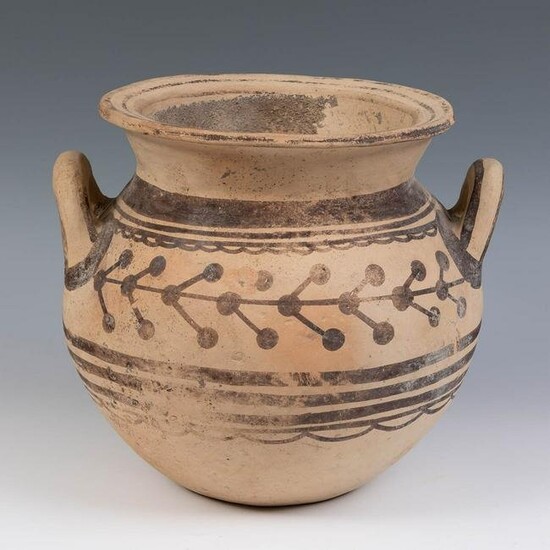Dauno-Messapien vessel, 5th century BC. Polychrome
Vase from the Dauno-Mesapia culture, southern Italy, 5th century BC.
Polychrome terracotta.
Provenance: French collection.
Measurements: 24 x 28 cm (diameter).
Dauno-Mesapia vessel made entirely of polychrome terracotta decorated with horizontal bands and geometric motifs. It has a globular belly, a wide mouth and two handles on the sides. The vessel comes from the region of Apulia in southern Italy, where Daunia, now the province of Foggia, and Mesapia, in the southern part of the region, are located. Towards the end of the Bronze Age (11th-10th centuries BC), Illyrian populations arrived in Apulia from the eastern Adriatic, probably crossing a narrow strip of water between Albania and Italy. The Illyrians in Italy created the Yapigian civilisation, which consisted of three tribes: the Peucetians, who occupied the Bari region, the Mesapians and the Daunians. Apulia differed from the other two regions inhabited by the Yapigians in that it was at a greater distance from the Greek colonies, with which it therefore maintained fewer connections. As it was also less influenced by the Campanian civilisation, it developed a more distinctive culture, in which the Daunian stelae (7th-6th century BC) are particularly noteworthy. Particularly striking is the pottery from this region, still little studied, which began with a purely geometric language but came to include synthesised representations of human figures, animals and plants. Like all pottery from this period and culture, it is clearly inspired by contemporary Greek models or somewhat earlier, with a certain difference in terms of composition and quality of both the material and the decoration on the vessel.
Estimate
Time, Location
Auction House
Vase from the Dauno-Mesapia culture, southern Italy, 5th century BC.
Polychrome terracotta.
Provenance: French collection.
Measurements: 24 x 28 cm (diameter).
Dauno-Mesapia vessel made entirely of polychrome terracotta decorated with horizontal bands and geometric motifs. It has a globular belly, a wide mouth and two handles on the sides. The vessel comes from the region of Apulia in southern Italy, where Daunia, now the province of Foggia, and Mesapia, in the southern part of the region, are located. Towards the end of the Bronze Age (11th-10th centuries BC), Illyrian populations arrived in Apulia from the eastern Adriatic, probably crossing a narrow strip of water between Albania and Italy. The Illyrians in Italy created the Yapigian civilisation, which consisted of three tribes: the Peucetians, who occupied the Bari region, the Mesapians and the Daunians. Apulia differed from the other two regions inhabited by the Yapigians in that it was at a greater distance from the Greek colonies, with which it therefore maintained fewer connections. As it was also less influenced by the Campanian civilisation, it developed a more distinctive culture, in which the Daunian stelae (7th-6th century BC) are particularly noteworthy. Particularly striking is the pottery from this region, still little studied, which began with a purely geometric language but came to include synthesised representations of human figures, animals and plants. Like all pottery from this period and culture, it is clearly inspired by contemporary Greek models or somewhat earlier, with a certain difference in terms of composition and quality of both the material and the decoration on the vessel.



